The 8 best Zoom Webinar alternatives in 2025
This is the complete list of the 8 best alternatives to Zoom Webinar for 2025. Each webinar platform is reviewed with its background, G2 rating, pros and cons, use cases, and a quick summary. We’ll also take a look at what Zoom Webinar offers - and give you a 6-step video checklist to help you choose the right alternative.
TLDR; if you can't wait - here is list of the 8 top Zoom Webinar alternatives:
- Univid - Smooth and engaging webinars, blazingly fast
- GoToWebinar
- Microsoft Teams
- Demio
- Webex
- BigMarker
- ON24
- Demio
Choose the right alternative webinar software - 6 step checklist [guide]
Choose the right webinar software and alternative to Zoom Webinar by following this 6 step checklist and video guide.
Zoom Webinar about
Zoom is a U.S. based meeting software that also offers a webinar add-on called Zoom Webinar. Zoom Video Communications was founded in 2011. Typically, you download Zoom software on your computer and can then host and attend webinars.
Zoom Webinar review
Zoom Webinar can be a good starting point if you are already in the Zoom suite. However, Zoom have their background in video conferencing - which means they might not fill all your webinar needs if you look for a dedicated webinar tool in 2025; both in terms of branding options, engagement features and attendee experience.
In August 2023, controversies surfaced around Zoom's Terms of Use, as the company reserved the right to train AI models on call data (all plans), with no clear opt-out. Zoom have since made adjustment to their ToS, but privacy experts report there are still ambiguities around the broad categorization of "Customer Content" and associated metadata.
Some webinar hosts also complain about having attendees not being able to join due to company security policies. And due to Zoom's size - hands-on support is something you cannot expect. With a 4.4 in user reviews on G2 - there are more modern alternatives with higher ratings to consider in 2025.
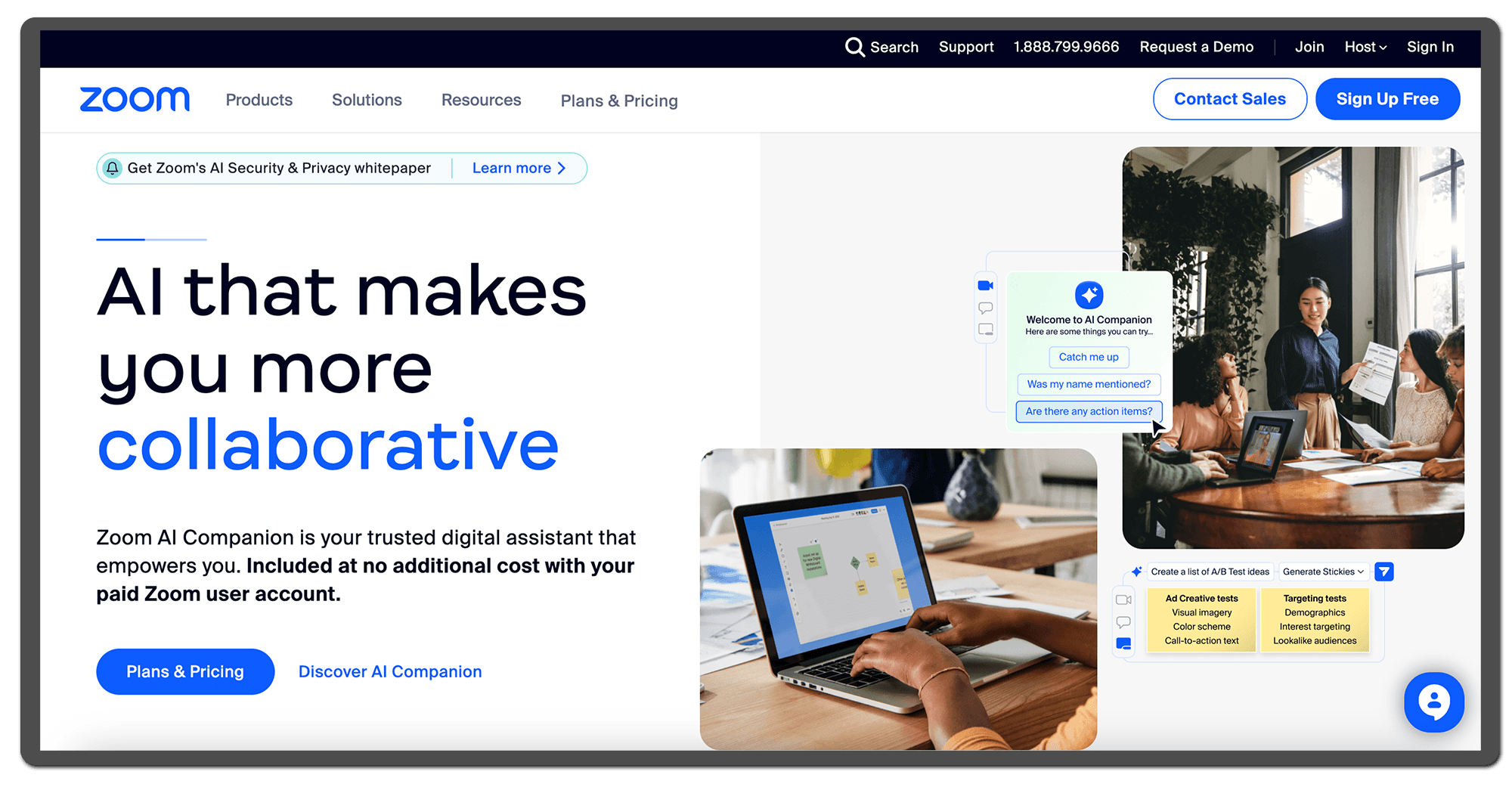
The Zoom Webinar landing page
Zoom Webinar G2 rating

Zoom has a solid rating on G2, showing users are quite happy. Still slightly lower compared to Demio's 4.6, and with platforms like Univid scoring a 4.8 on G2.
Zoom Webinar pricing
Zoom Webinar is priced based on the number of live attendees you expect to attend, and how many users (hosts) you need. They offer 3 different license types: Zoom Webinar, Zoom Sessions and Zoom Events. However, it might be complex to understand what plan to choose - and what limitations apply.
For example, some functionality like event branding is only available in the more expensive annual Zoom Session package, and Zoom Webinar is only available at 500+ attendees.
The prices are billed annually, and start at:
$990 / license / year - < 100 attendees
$3490 / license / year - < 500 attendees
$6790 / license / year - < 1000 attendees
$19990 / license / year - < 3000 attendees
Note: the pricing is based on the number of licenses you need, which means it can get quite expensive to scale your webinar initiatives, paying for multiple hosts.
Why look for a Zoom Webinar alternative in 2025?
If you're searching for a Zoom Webinar alternative – chances are you're looking for a better way to run webinars in 2025. Faster, more effortless, and engaging. And with real results that show up in your pipeline.
As you probably know, the webinar space has not changed much in the latest decade. Platforms like GoToWebinar, Zoom and others have been around for years. But they’re built for another era.
Meanwhile, your audience has changed. And attention spans are shorter. Downloaded software, security issues, and technical hassle is not just what modern attendees will sign up for.
If you want attendees to convert – your webinars need to level up.
Before choosing a webinar tool in 2025: Tick these 3 boxes
The webinar platform you choose in 2025 should enable you to create webinars that stand out (see the webinar software buyer’s guide).
And standing out requires the right platform. Based on real data, and experience of hosting 1000s of webinars, your next webinar software should allow you to do 3 things:
✅ Move fast
Easily set up webinars and collaborate with guest speakers, colleagues and moderators – without the tech struggle.✅ Keep attention
Use polls, and live reactions to let attendees shape the session. Not just a passive Q&A at the end.✅ Drive next steps
No pipeline, demos, or MQLs happen without clear next steps. And that does not just mean dropping a cold link in the chat. Launch call-to-action buttons live, at the right time, and sync data into your CRM via a webinar integration.

Ready to find your next platform?
Well, if you are in the search for a new webinar tool. Here is a curated list of platforms that go beyond the basics of Zoom, Teams, and GoToWebinar – and can level up your webinar game in 2025.
We included 8 alternatives below - with reviews, G2 scores, pricing details, and who each tool could be best suited for.
The 8 best alternatives to Zoom Webinar in 2025
1. Univid - Smooth and engaging webinars, blazingly fast
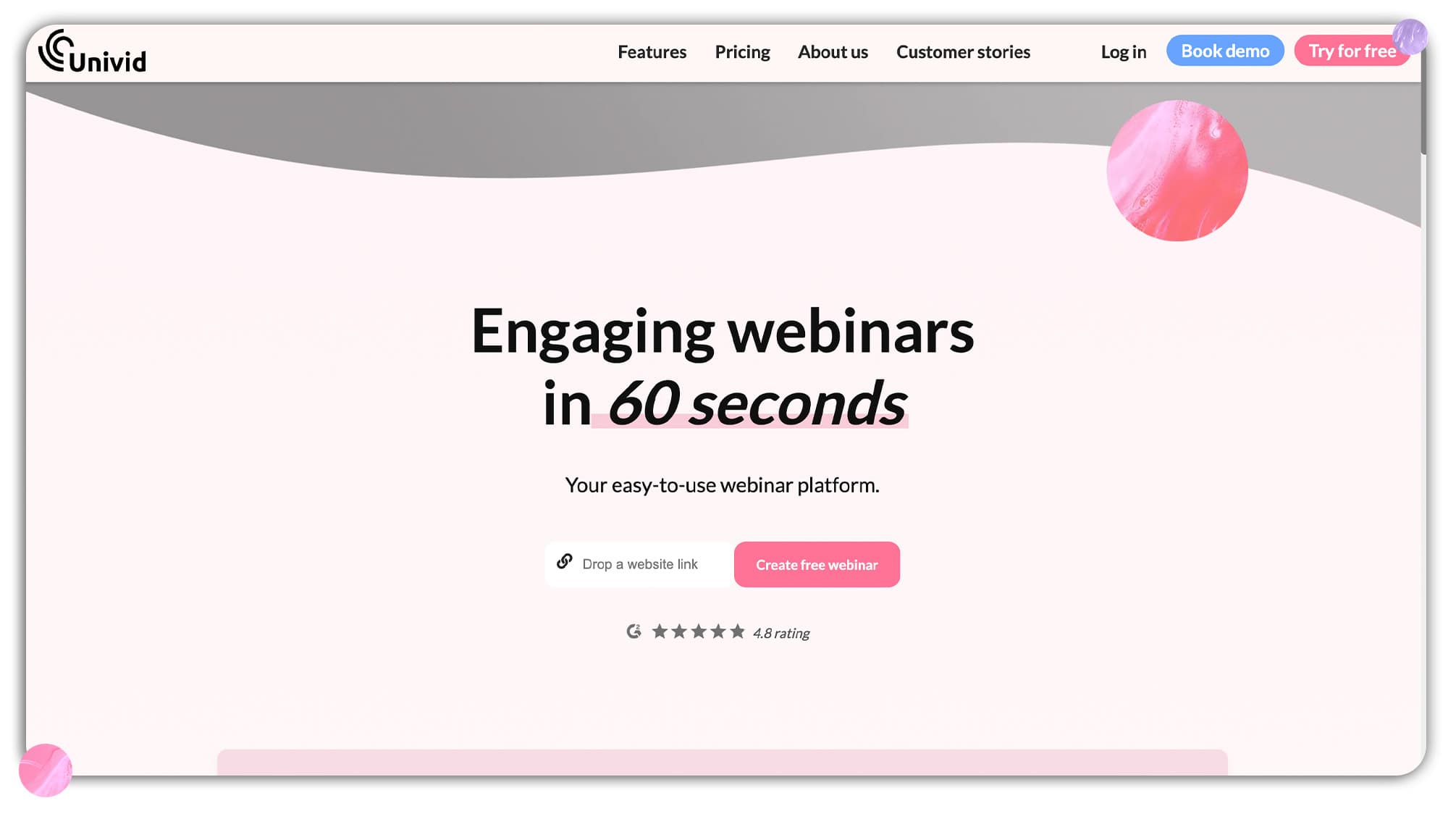
The Univid landing page
About
Univid is a webinar tool to create engaging and branded webinars in 60 seconds. Founded in 2019 in Sweden (EU), Univid is one of the most modern players on the market, challenging the status quo. Univid is built to smoothly create engaging webinars to impress, engage and convert attendees in 2025.
Review
If you're looking for an easy-to-use alternative to Zoom Webinar - Univid can be just the right next step for you.
No downloads required. Easy to set up. Easy to bring new people with no prior experience of webinars. And you can get started and set up a branded webinar in 60 seconds.
Here is how Univid can be a solid Zoom Webinar alternative - with three main benefits:
1. Easily set up beautiful webinars
Univid is an easy-to-use platform, where you can set up a branded webinar in just 60 seconds. AI-assisted set up helps you as a marketer in 2025 get your branding right to stand out - with everything from landing page, reminder emails, logos and themes. Try for free here.
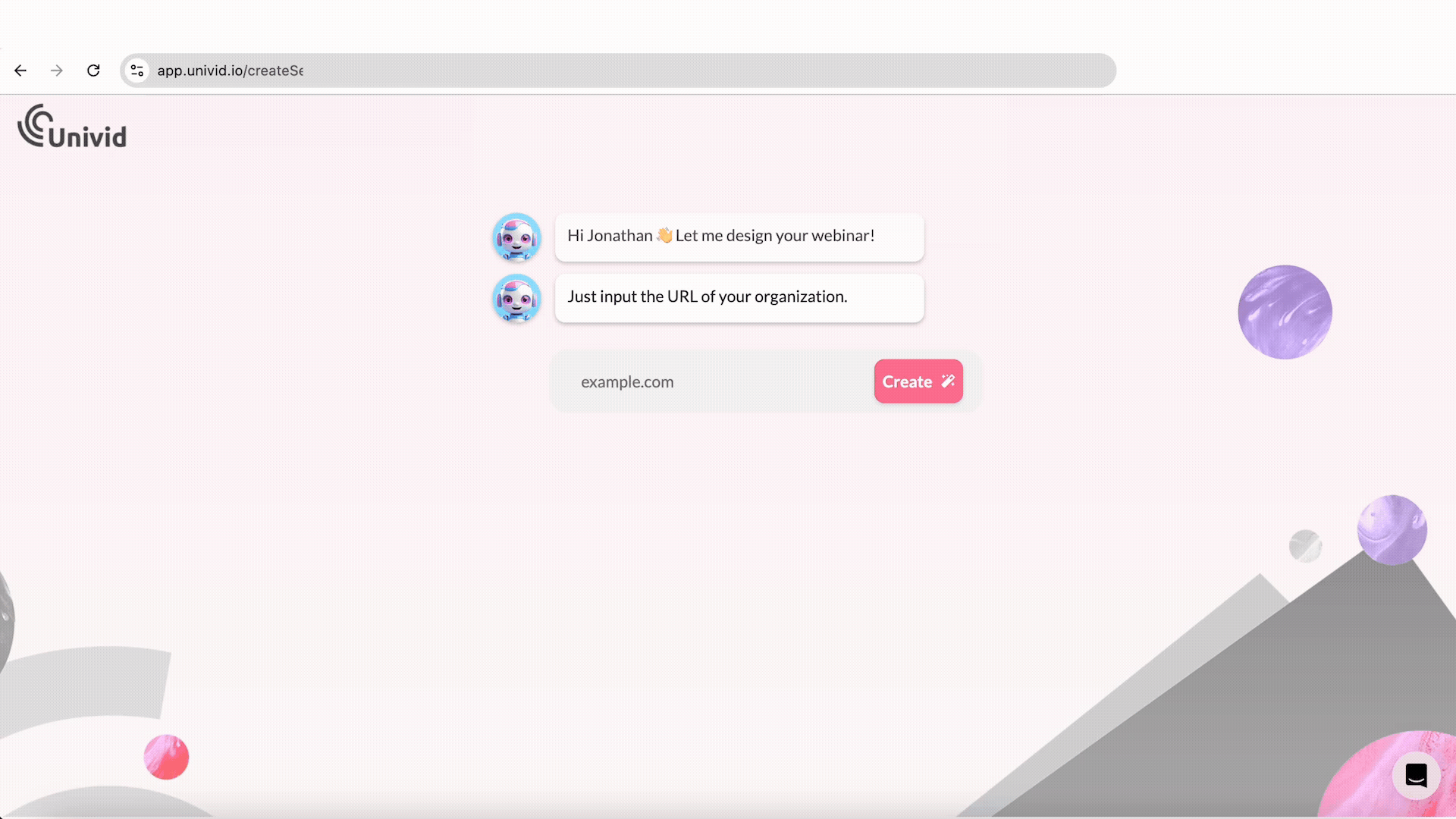
The ease-of-use is key when collaborating with new guest speakers and onboarding new colleagues. A low learning curve equals a smooth workflow for you as a webinar coordinator.
You can also set up webinar templates in Univid with your favorite themes, settings and engagements like polls. Use templates to copy + paste everything to your next webinar.
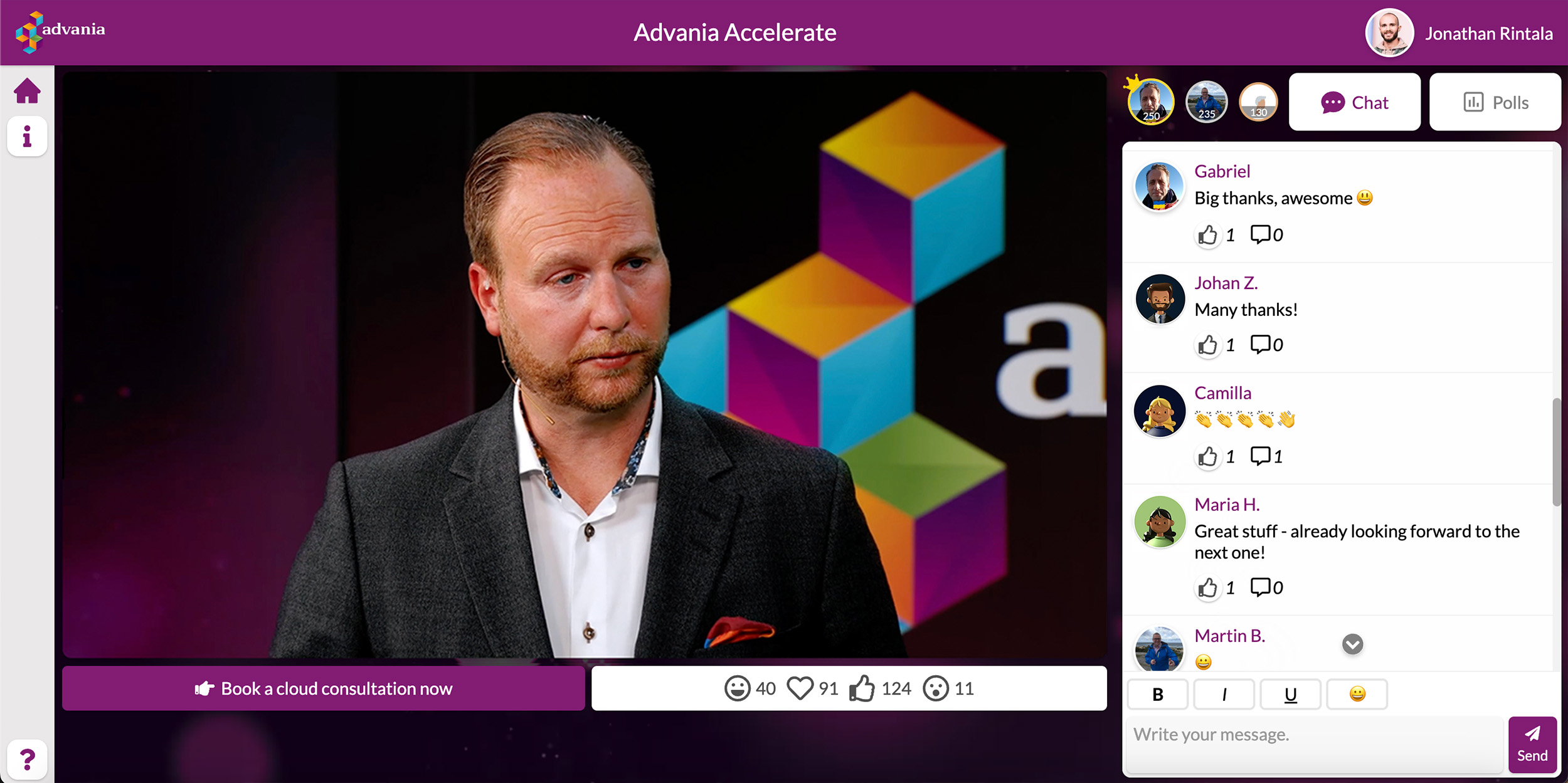

Branded webinars created by hosts using Univid
2. Host engaging webinars
Univid goes beyond the basics of engagement - and offers beautiful polls (branded to your session), Q&A, chat and live reactions built for the 2025 webinar attendee.
But also interactive features - to make sure attendees do not tab out, but rather stay focused and become your brand ambassadors.
Engagement features in Univid
And finally, Univid offers CTA buttons to drive valuable next steps like “book 15 min meeting”, “try it yourself” or “download e-book”. This is shown to increase conversions with up to 50% and convert warm leads in real time. Not relying on the cold follow-up email, like in the old days.
3. Top rated support
Univid offers top rated support that you can trust - and that will help make your webinars successful.

The webinar basics - check
Univid got all the basic webinar functionality you need - and some extra:
Branded webinar registration page and reminder emails
Attendee insights and analytics
Automatic recordings in full HD (1080p)
Pre-recorded, on-demand and simulated webinar mode
CRM integrations to HubSpot, Salesforce, Pardot, Pipedrive, etc.
G2 rating

Univid has an excellent rating on G2 of 4.8 and 5.0 on Capterra (in the top for G2 rating on this list) - indicating that users are happy with the platform. For example, compared to GoToWebinar's 4.2 and Zoom's 4.4.
Summary
If you’re looking for a smooth way to host engaging webinars - Univid is the best Zoom Webinar alternative in 2025.
The platform is easy-to-use and has top rated support. Finally, Univid features a top G2 rating of the platforms on the list with 4.8/5 in user reviews.
Get started todayJoin over 70,000 users and create unique webinars with Univid.Book demo
2. GoToWebinar
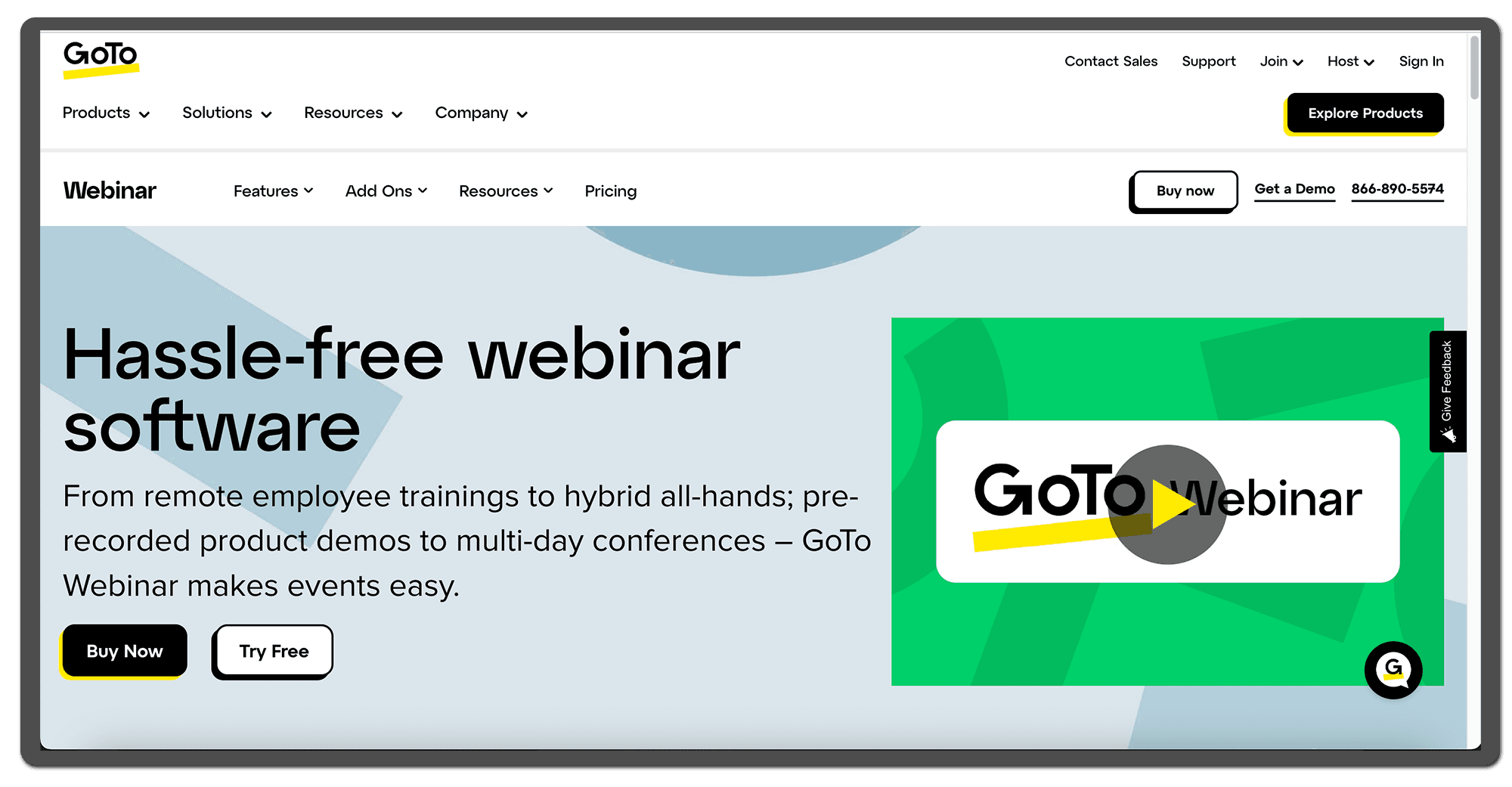
The GoToWebinar landing page
About
GoToWebinar is a webinar software in the GoTo suite, founded in 2003. This U.S. based company provides a variety of software for video communication that you download on your computer - such as GoTo Meeting, GoTo Webinar, GoTo Room, etc. Not just webinars.
Review
GoToWebinar provides hosts with all the basics to create and run webinars for their audience at an affordable price. The webinar tool involves features such as registration pages, live streaming, slide sharing, and basic engagement tools.
GoToWebinar offers a variety of integrations to CRM:s and marketing automation systems to fit in the ecosystem. As well as options to adjust for different languages, and launch pre-recorded webinars. Typically, one need to download software to use GoToWebinar's full functionality.
G2 rating

GoToWebinar has a decent rating on G2, showing users are quite satisfied with the webinar software - being one of the largest actors in the space. However, note that with a score of 4.2 - this is the lowest G2 score on this list compared to Webex's 4.3, and with platforms like Univid scoring a 4.8 on G2.
Pros
Many language options and CRM integrations
Recognized player in the webinar industry
Affordable price point
Offers pre-recorded and simulated webinars
Cons
Downloads required for full attendee experience
Outdated and clunky interface (difficult to navigate)
Not a lot of branding capabilities to meet attendee expectations in 2025
No free version (but 7 day trial available)
Conclusion
GoToWebinar is a widely recognized player in the webinar industry, as one of the first actors to enter the space, and used by alot of companies still today. With many integrations and language options GoToWebinar can be a good alternative to Zoom Webinar. However, GoToWebinar has the lowest score on G2 on the list; and with its limited branding capabilities and a slightly outdated interface, there are other more modern alternatives in the list to consider to create engaging webinar experiences in 2025.

3. Microsoft Teams
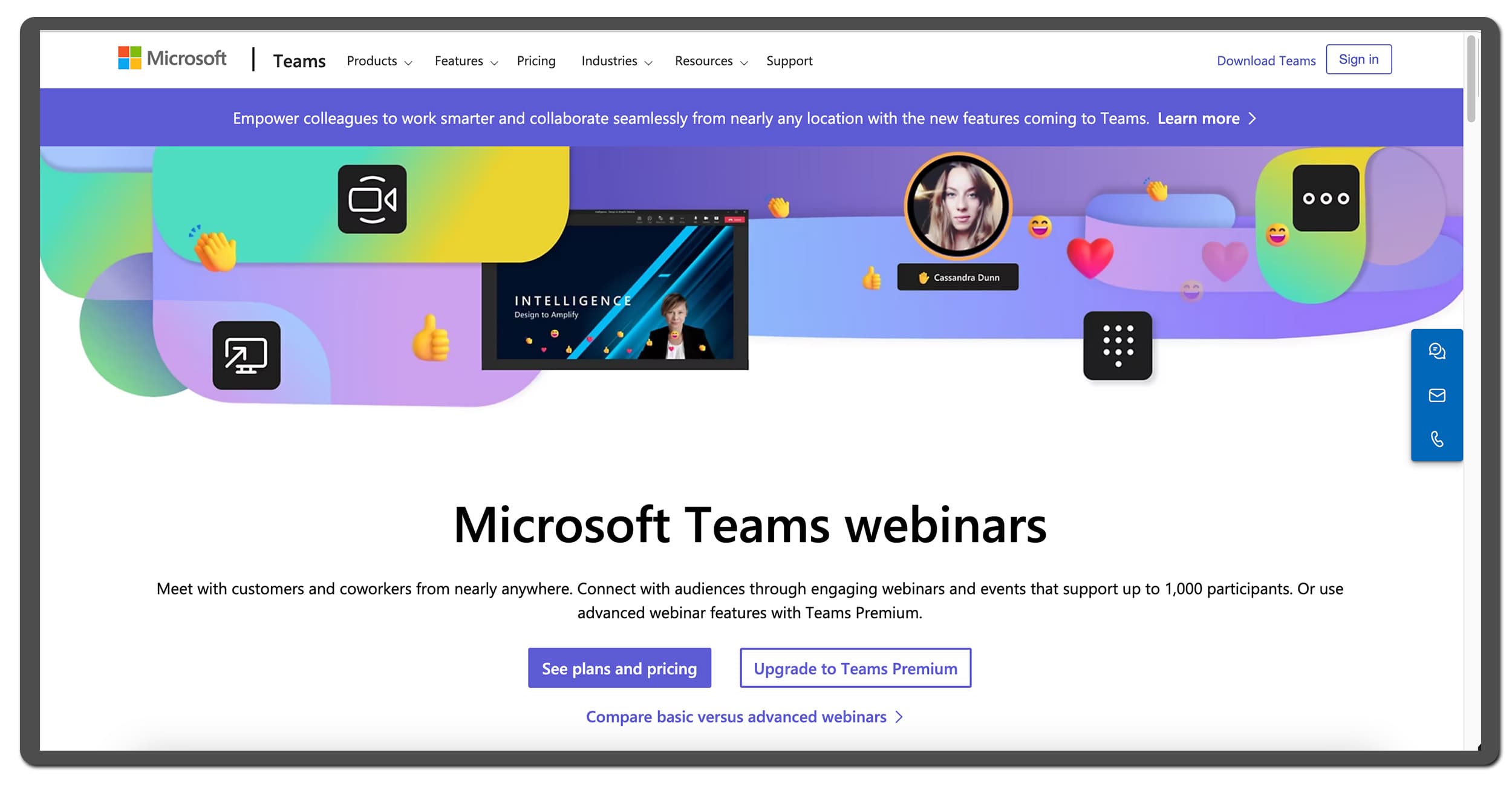
The Microsoft Teams webinars landing page
About
Microsoft Teams is an all in one tool designed for team communication and collaboration, offering features such as chat, file sharing and project collaboration. Initially built for virtual meetings in 2016, Teams has expanded their offer to virtual events and webinars too, with sub-products like Microsoft Teams Webinars.
Review
Teams has a lot of functionality. However, users express feedback and room for improvement in user experience (UX) design. Navigating around the platform and into the webinar might get complex and "overwhelming" at times, both for participants and hosts.
Some webinar hosts also complain about having attendees not being able to join due to company security policies. Due to Microsoft's size, hands-on support is something you cannot expect. With a 4.4 in user reviews on G2 – there are more modern alternatives with higher ratings to consider in 2025.
G2 rating

Microsoft Teams has a solid rating on G2, showing users are quite happy. The platform is similarly rated compared to Zoom’s 4.4, but still lower than platforms like Univid scoring a 4.8 on G2.
Pros
Most attendees know of or are are familiar with Microsoft Teams
Possible to integrate with Microsoft Office 365
A lot of features that can be used in a complex setup
Cons
Learning curve, navigating the platform can be complex
Overwhelming due to all the extra features that can feel cluttered
Limited branding and customization options
Conclusion
As a well-known platform, Microsoft Teams can be a option to Zoom. Especially if you are already using Teams and want a quick solution – not worried about providing the most modern attendee experience. However, if you aim to engage your attendees and potential leads, you may want to explore the more modern webinar platforms in the list.
4. Demio
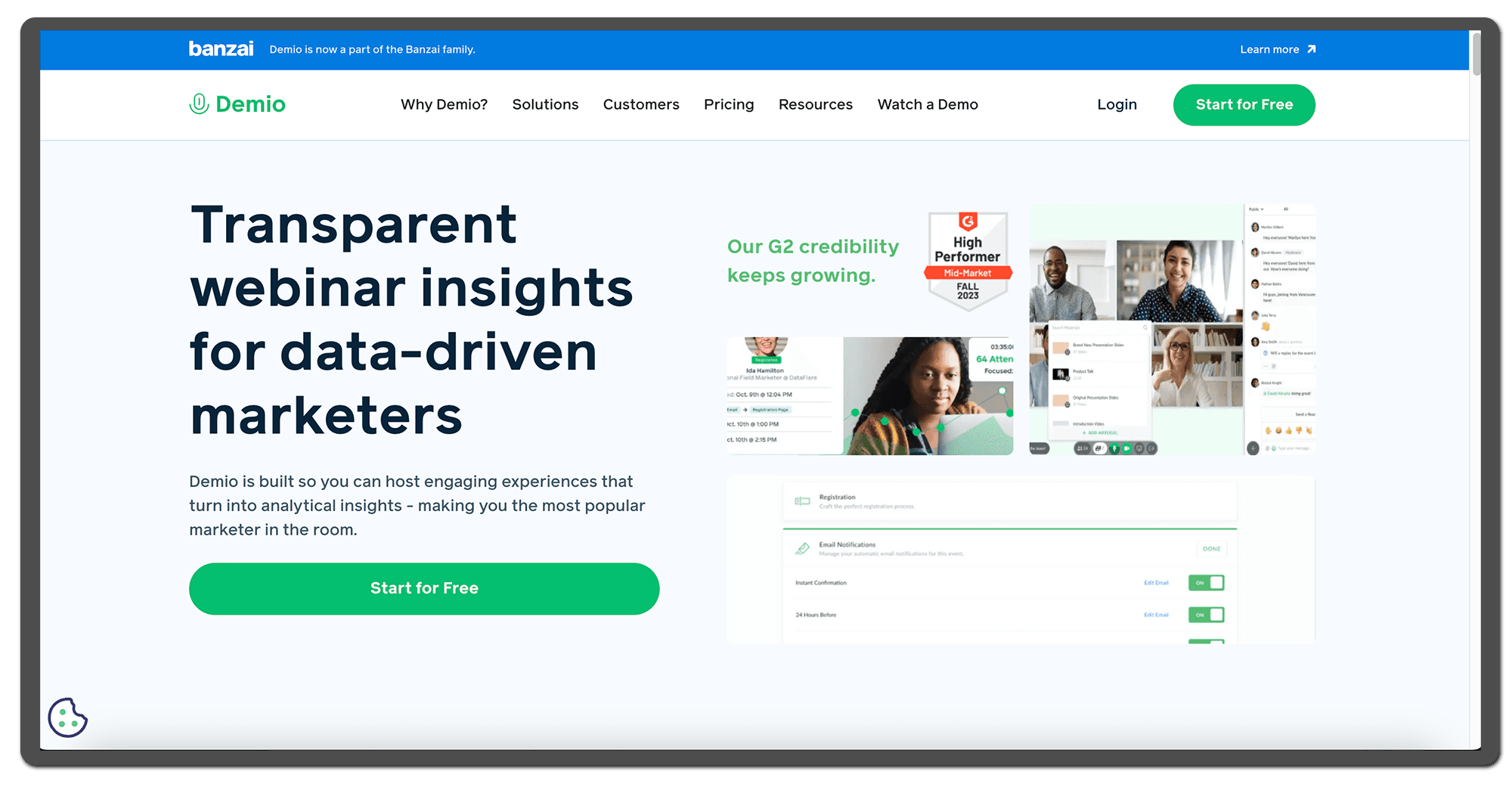
The Demio landing page
About
Demio is a webinar platform founded in 2014 with the aim to provide hassle-free software for marketers, now owned by the U.S. marketing platform Banzai.
As a Zoom Webinar alternative, Demio covers the basics for hosting webinars (landing pages, emails, video, analytics). At a relatively affordable price, Demio allows attendees to easily join webinars from their browser. Also, with the basic engagement features (polls, chat, Q&A), and even offers breakout rooms and meeting options.
Review
Demio offers the basics for hosting meetings and webinars with engagement at a fair price point. Given that you can commit for the full year upfront as they only offer annual plans if you want more than 6 people on stage, dedicated support, or CRM integrations. In 2025 Demio can look a bit outdated for hosting webinars - both in terms of branding options, video quality, and attendee experience.
G2 rating

Demio has a solid rating on G2, when comparing webinar softwares like Zoom Webinar and Webex. But it still leaves room for improvements in user satisfaction, with webinar platforms like Univid ranking higher in user reviews.
Pros
Host webinars completely browser-based
Easy to use and setup
Breakout rooms and meeting functionality
Cons
Annual plan required for CRM integrations, priority support, or > 6 people on stage
Slightly outdated attendee experience and limited branding options
No free plan - only a 14-day free trial
Conclusion
If you are looking for an easy-to-use tool that covers both meetings with breakout rooms, and webinars, Demio might be a good option to Zoom Webinar. However, if you want something more flexible pricing wise, and want a modern attendee experience with more branding options - you should check out some of the more modern alternatives in the list.
5. Webex
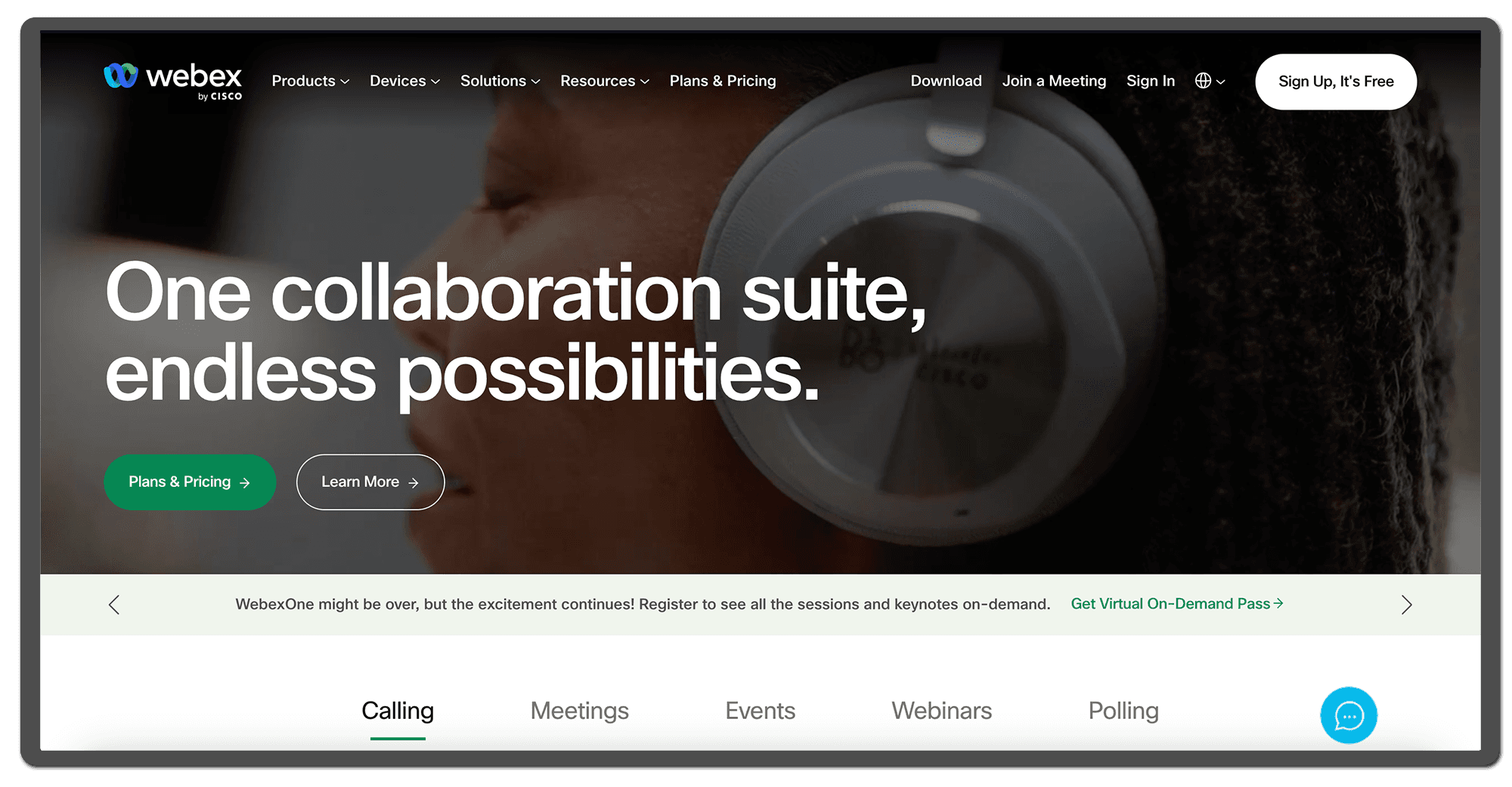
The Webex landing page
About
Webex is a traditional webinar tool owned by the U.S. tech giant Cisco and was founded in 1995. Webex is built to support a wide variety of events such as meetings, virtual events, and in-person events. Not just webinars.
Review
Webex can be a good alternative to Zoom Webinar if you are looking for a full suite that covers not just webinars.
If you are looking for a secure tool to host meetings, large virtual events, or small webinars - Webex can be a solid choice. For example, providing AI note-taking functionality for more productive meetings.
G2 rating

Webex has a decent rating on G2, showing users are quite happy. But still one of the lower G2 scores on this list compared to Zoom's 4.4, and with platforms like Univid scoring a 4.8 on G2.
Pros
Breakout rooms, available on all plans
Gamification for virtual events
End-to-end encryption for secure video communication
Cons
Slightly outdated interface
Tool designed primarily for meetings
App download required for optimal experience
Conclusion
Webex can be an alternative to Zoom Webinar for hosting webinars - given that your main priority is security, or that you host either large meetings or small webinars. Keep in mind though - Webex is a U.S. based company. And if you are hosting marketing webinars - there are more qualified options in the list.
6. BigMarker
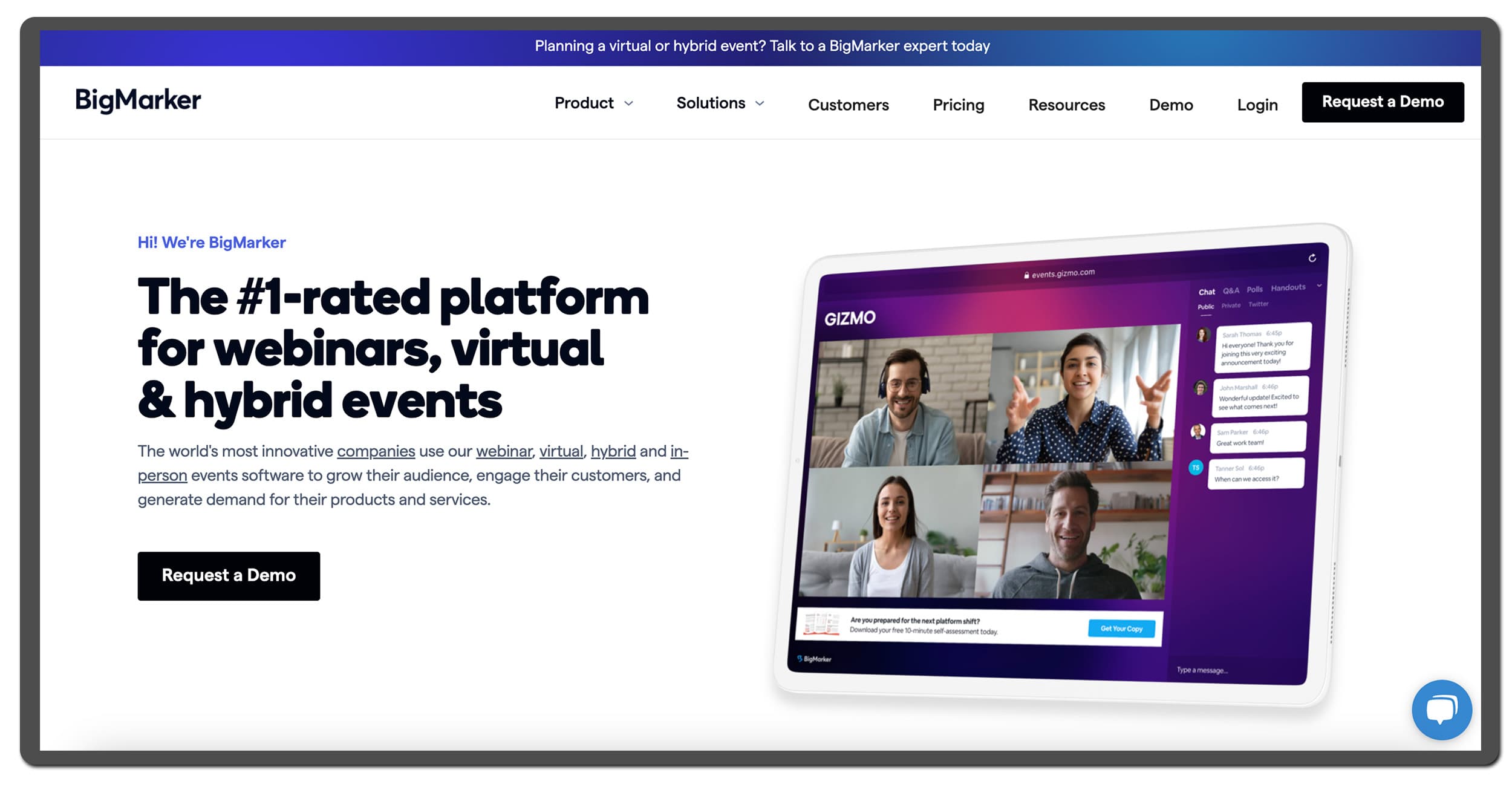
The BigMarker landing page
About
BigMarker is a platform for hosting not only webinars, but also virtual and hybrid events. The U.S. company was founded in 2010.
BigMarker covers the basics for webinar hosting including registration pages, analytics, emails and video. BigMarker also offers some of the basic engagement features like polls, chat, Q&A and some analytics.
Review
BigMarker is a solid webinar tool with a lot of complex functionalities that allow you to run all types of virtual events, webinars and hybrid events.
However, it is not the most beginner-friendly platform in the list. Users on review sites like G2 report that it can be a high learning curve with "almost too many options and settings". Users also report BigMarker can get expensive and note that there are no public pricing plans available.
G2 rating

BigMarker has a rating of 4.7 / 5 on G2. A solid score when compared to webinar platforms like WebinarJam and GoToWebinar, showing users are pretty happy. Although, it is still lower compared to platforms like Univid that scores 4.8 on G2.
Pros
Several branding features
The set up is easy to understand
Gamification and lead scoring available
Cons
One of the most expensive webinar platforms on the list
The participant view is average
Native CRM integrations to HubSpot and other CRMs only available on the most expensive tier with up to 500,000 Live Attendees
Conclusion
BigMarker is a solid alternative to Zoom Webinar if you have money to spend on your webinar platform. However, if you want your attendees to have an experience with something extra, note that the attendee view in BigMarker is not as modern compared to other tools in this list.
7. ON24
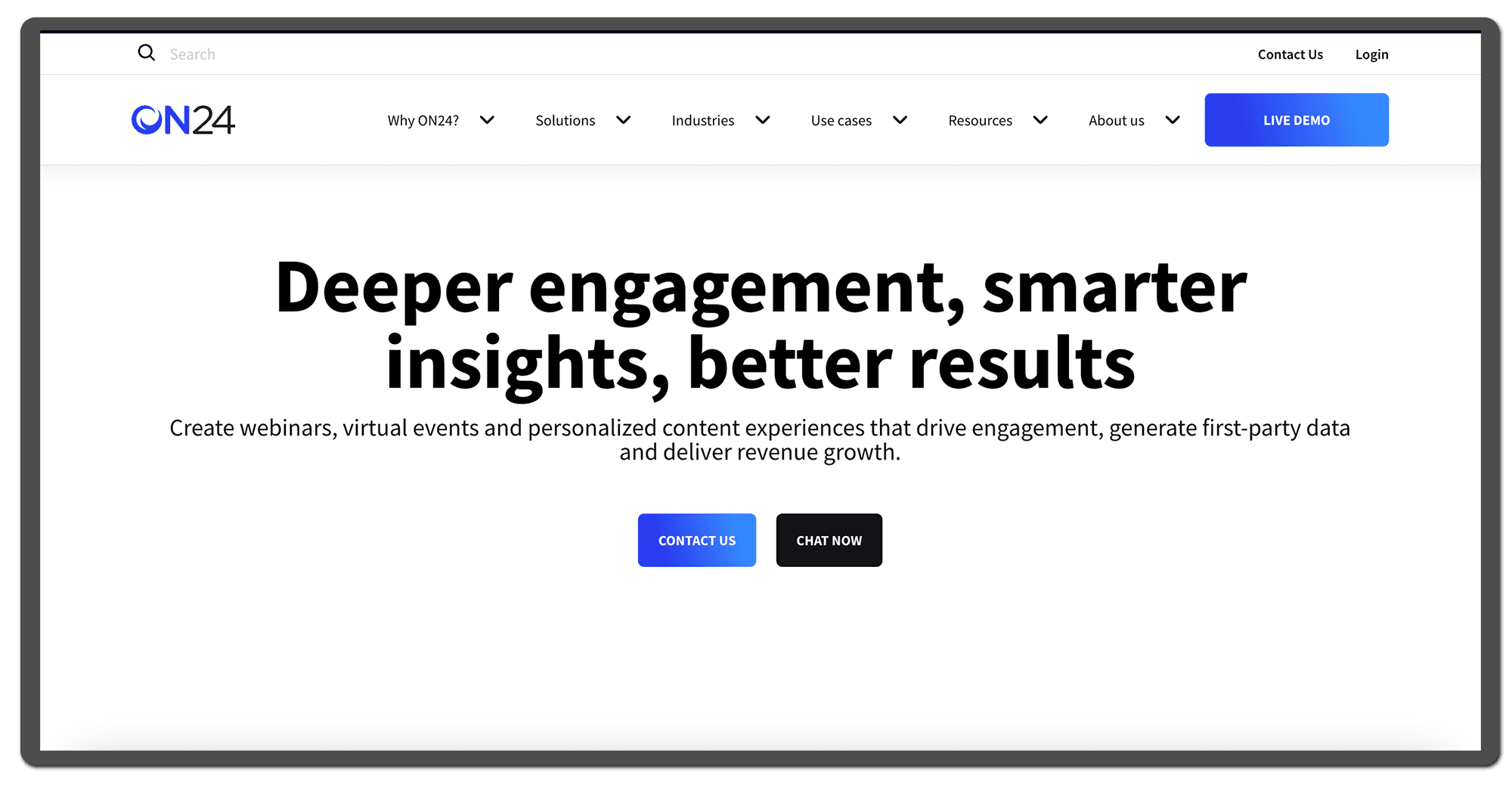
The ON24 landing page
About
ON24 is a webinar and virtual events platform targeted towards the enterprise segment who can pay top dollar. Founded in 1998 this U.S. based company provides a wide range of tools for webinars, virtual events, and personalized content experiences. Not just webinars.
Review
ON24 is a solid webinar tool with a lots of complex functionality that allows you to customize your workflows around webinars, set up content hubs, do advanced reporting, and custom configurations. Also, with good branding options for reminder emails and registration pages.
ON24 offer enterprise-level security with SOC Type 2 and ISO 27001, as well as ISO 27701 certifications.
However, it is not the most beginner-friendly platform in the list, and users report they often require in-house resources to educate and manage the webinars - in a slightly outdated interface.
G2 rating

ON24 has a decent rating on G2, showing users are quite happy. But still one of the lower G2 scores on this list compared to Zoom's 4.4, and with platforms like Univid scoring a 4.8 on G2.
Pros
Complex webinar setups
Extensive webinar insights and reporting functionality
Branded landing pages and emails
Engagement features: polls, Q&A, gamification
Cons
Not for beginners or small webinar teams
Complex and clunky user interface
No public pricing listed
Difficult to interact as attendee
Conclusion
ON24 can be a powerful webinar tool if used right, with both engagement features and branding options. Also, if advanced reporting functionality is what you are after - ON24 might be the right choice. However, rated 4.3 on G2, there are platforms in the list with higher user reviews. Users report on a "steep learning curve" being the main challenge.
8. Demio

The Demio landing page
About
Demio is a webinar platform founded in 2014 with the aim to provide unfussy software for marketers, now owned by the U.S. marketing platform Banzai.
Demio covers all the basics for hosting webinars including landing pages, emails, video, and analytics. At a relatively affordable price, Demio allows attendees to easily join webinars from their browser. The platform has the basic engagement features (polls, chat, Q&A), even breakout rooms and meeting options are provided.
Review
Demio is a solid webinar platform that offers the basics for hosting meetings and webinars, with engagement features, at a fair price point.
That is, given that you can commit for the full year upfront as they only offer annual plans if you want to have more than 6 people on stage, dedicated support or direct CRM integrations. In 2025 Demio can look a bit outdated for hosting webinars, both when it comes to branding options and attendee experience.
G2 rating

Demio has a rating of 4.6 out of 5 on G2. A solid score when compared to webinar platforms like Webex and GoToWebinar. Although, there is still room for improvement in user satisfaction, compared to platforms like Univid scoring 4.8 in user reviews on G2.
Pros
Attendees can join from their browser
The platform is easy to use
Engagement features like Q&A, polls and chat
Cons
No free plan available
Viewer experience can look outdated
You need to upgrade to one of Demio’s yearly plans If you need CRM integrations like Hubspot or salesforce, want priority support or more than 6 people on stage
Conclusion
Demio is a good webinar platform alternative if you are looking for a tool that is easy to use and is equipped with engagement features. However, if you are just getting started with hosting webinars and don’t want to pay for a yearly subscription, you might want to consider other options. Also, there are alternatives out there with a more modern participant view.
To conclude: The best 2025 alternative to Zoom Webinar
Zoom is a U.S. based meeting software that also offers the webinar add-on - Zoom Webinar, that can be downloaded to your computer to host webinars. Zoom has had some issues around security - but if you are already in the Zoom suite, and security is not your main concern - Zoom Webinar can be a good choice as it got all the basic functionality. With 4.4 in user reviews on G2 - there are more modern dedicated webinar platforms with higher ratings to consider in 2025.
Whether you're looking for a simpler setup, stronger branding, or better audience engagement than what you currently have in Zoom Webinar - it's worth trying tools that match your goals in 2025. For example, you can consider top rated alternatives like Univid. Or for those of you with deeper pockets - it might also be worth checking out tools like BlueJeans or Livestorm.
